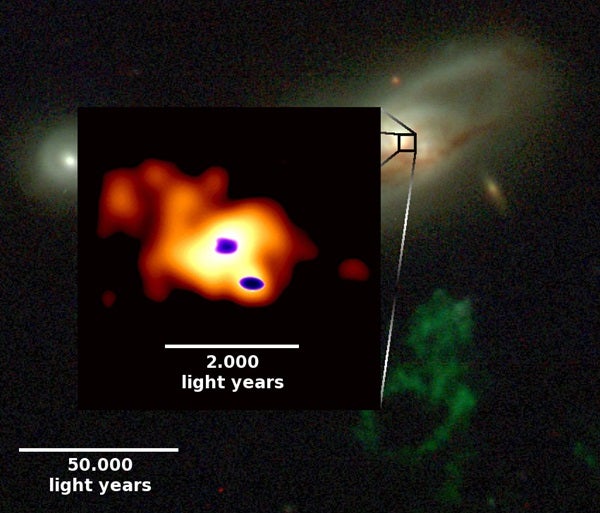A group of researchers, led by Michael Garrett, general director of the Netherlands Institute for Radio Astronomy (ASTRON), has made new high-resolution radio observations of the region of space around Hanny’s Voorwerp (Hanny’s Object), the mysterious, greenish gas cloud discovered by Dutch school teacher Hanny van Arkel.
The astronomers undertook an observational campaign at radio wavelengths using the European Very Long Baseline Interferometry Network (EVN) and the United Kingdom’s Multi-Element Radio Linked Interferometer Network (MERLIN), pointing their telescopes at the center of the neighboring galaxy IC 2497. In these measurements, several radio telescopes across Europe and the United Kingdom were linked together in real time in order to gain a detailed picture of the central region of the galaxy. They observed a field a few arcseconds (1/3600th part of a degree) across, with a spatial resolution of about 70 milliarcseconds (0.07 arcsecond).
“The observations show two bright and very compact sources with broadband spectra that argue strongly for the existence of an active galactic nucleus (AGN) at the center of the galaxy, IC 2497,” said Garrett. “One of the sources appears to be identified with the base of the supermassive black hole at the center of the AGN itself, while the other one is likely to be the result of an energetic jet expelled by the black hole and now interacting with the dense gas that surrounds IC 2497”. The radiation output from the AGN is believed to heat Hanny’s Voorwerp to a temperature above 10,000°.
It also appears that surrounding the AGN is a lot of extended radio emission. The researchers argue that this is radio emission associated with a nuclear starburst. “We knew that IC 2497 is forming stars, but we were surprised to find that the star formation seems to be concentrated in a very small central region, only 3,000 light-years across,” said Hayden Rampadarath from the University of Manchester, England. “It is fairly unusual to find both vigorous star formation and AGN radio activity in the same system and on similar scales. It seems that IC 2497 swings both ways,” said Garrett.
The radio observations show that in this small region, IC 2497 is producing stars with a total mass of 70 Suns every year. This star formation rate is large, especially in the local universe – it is about 6 times higher than in the nearby starburst galaxy, M82,” said Garrett.” “We know of only a few hundred of these types of galaxies, Luminous Infrared Galaxies (LIRGs), in the local universe,” said Gyula Jozsa, support scientist at ASTRON, “but they must have been much more frequent in the past”. At half the universe’s age, most stars have been formed in LIRGs. It is also typical that for this kind of galaxy large amounts of dust obscure optical and ultraviolet light towards the observer.
The observations support the group’s earlier hypothesis that a hidden AGN in the center of IC 2497 is ionizing a distinct region of gas that surrounds the giant galaxy. That distinct region is what we know as Hanny’s Voorwerp. Such phenomena must be rare in the local universe because they depend on a specific geometry of the observer, galaxy, and gas, plus the interaction of several galaxies in the field in order to fuel the AGN and the starburst, and to create the gas reservoir that forms part of the Voorwerp.










